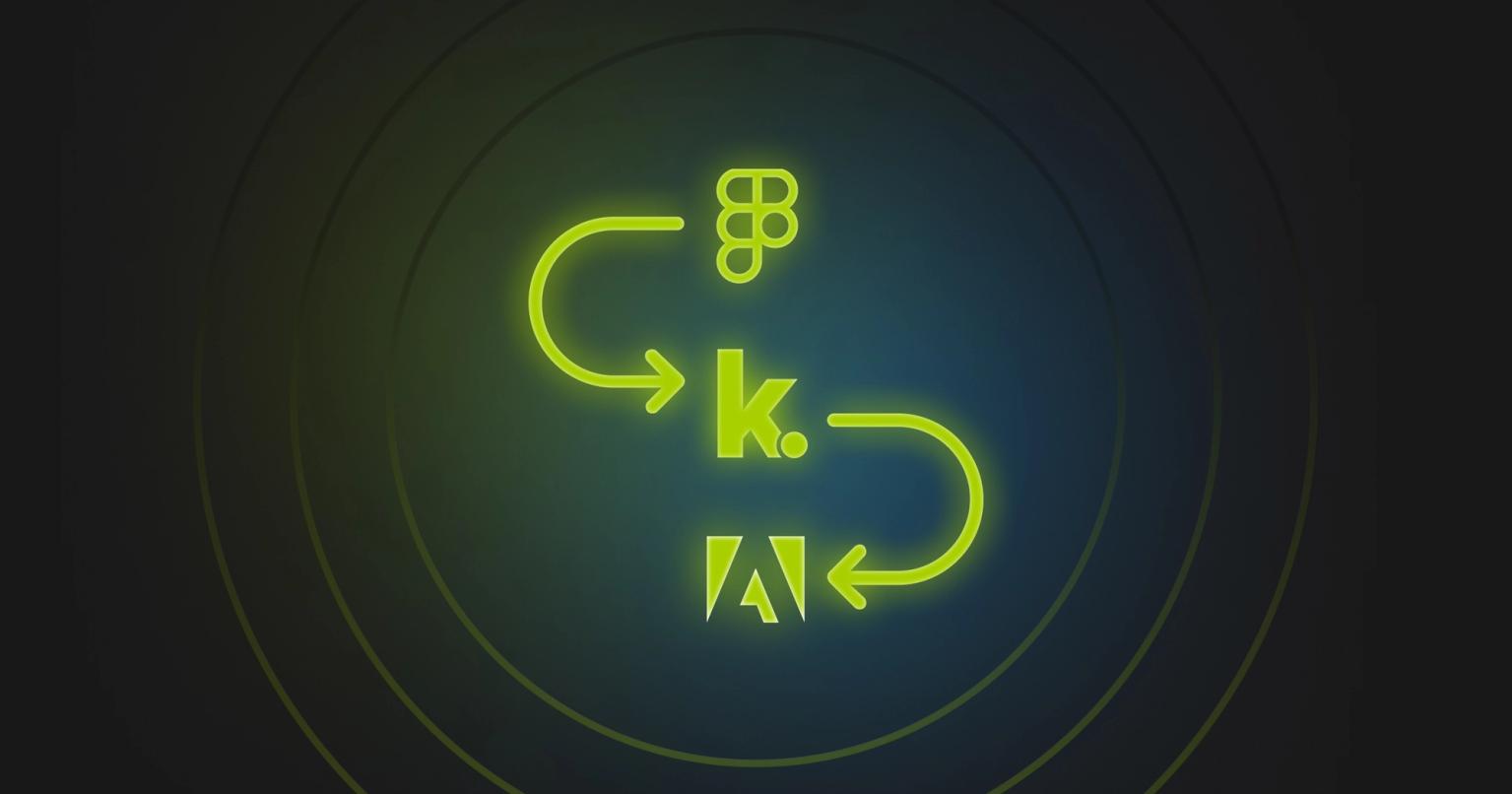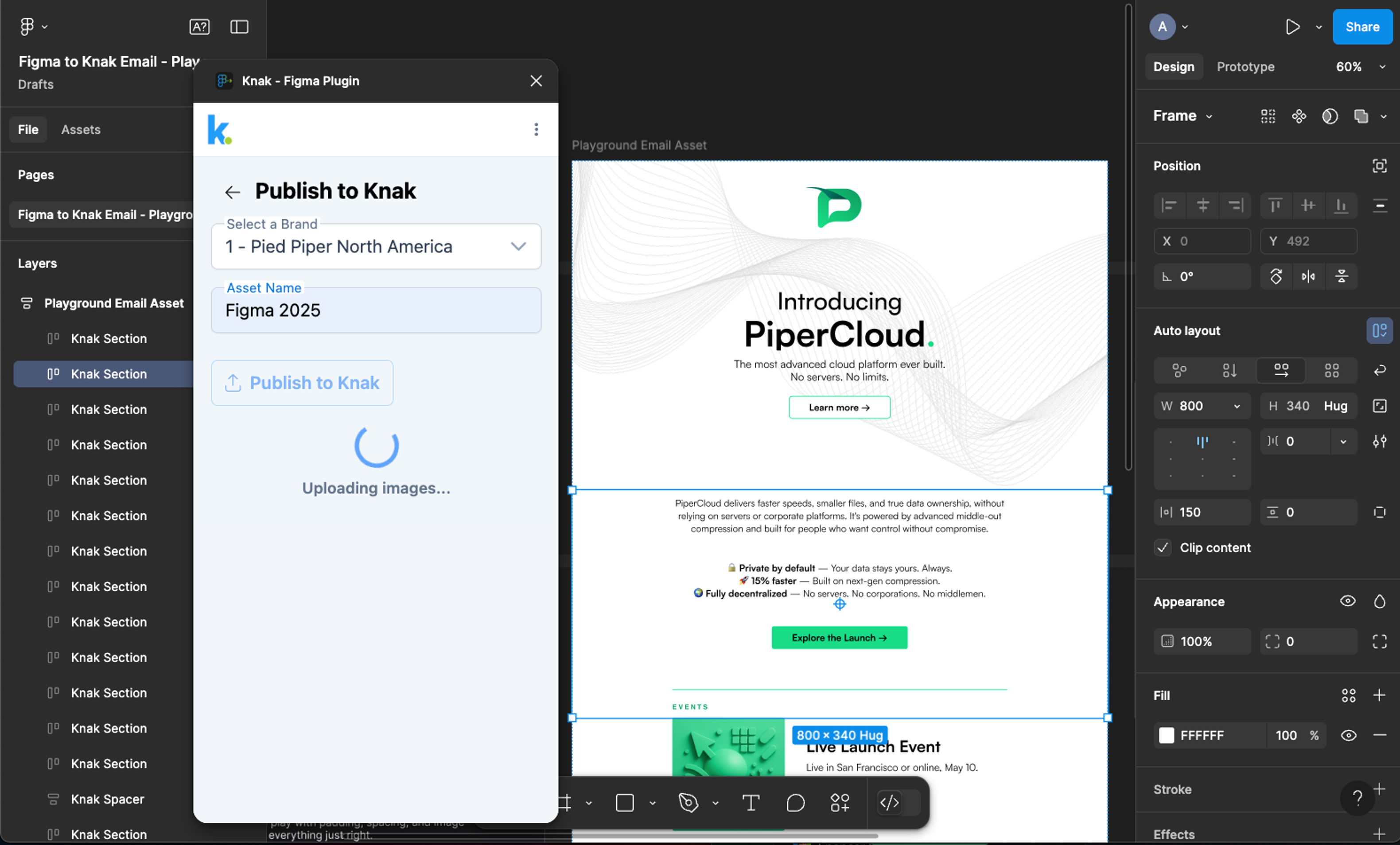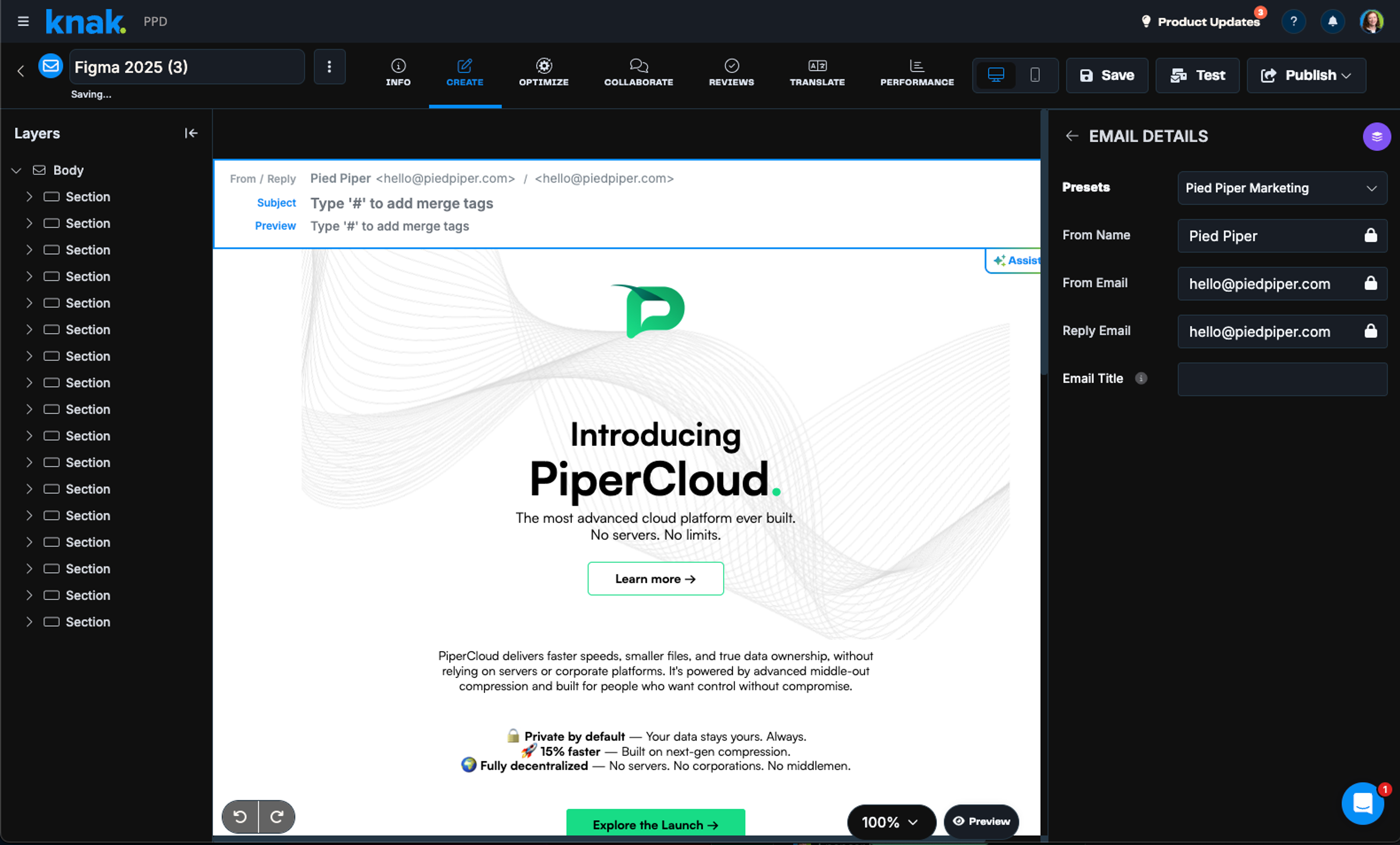From Figma to Marketo: Bridging the enterprise email design gap

Summary
Turn Figma designs into Marketo-ready emails in hours.
Your quarterly product release is two weeks away. The design team delivered comprehensive email templates in Figma last month, covering announcement emails, feature spotlights, and customer success stories. Everything is approved, on-brand, and ready. But between those polished Figma designs and your Marketo instance lies a translation process that typically consumes 8 to 14 working days.
This timeline isn't an exaggeration. Enterprise teams report spending days on initial handoff and interpretation, more days on manual rebuilding, then additional cycles for velocity scripting and testing across 15,000 possible email client rendering combinations. By the time emails deploy, marketing has missed optimal timing, and what reaches subscribers rarely matches the original design vision.
The challenge runs deeper than resource allocation. Marketo's Email Editor 2.0, despite its improvements in some areas, actually reduced flexibility from version 1.0. Modules can only stack vertically at full width. Custom layouts require extensive workarounds. Teams need expertise not just in HTML and CSS, but also in velocity scripting for personalization. When scripts grow beyond 40 tokens, they can delay email delivery by several seconds per recipient or fail entirely.
Many enterprise teams already implement hybrid workflows using external tools to bridge this gap. They've recognized that the path from design to deployment needs modernization. The question isn't whether to evolve the workflow, but how to do it while maintaining the governance, scale, and reliability that enterprise email programs demand.
The enterprise workflow that eliminates rebuilding
Consider a typical Marketo enterprise scenario: your B2B software company runs integrated campaigns across six product lines and four regions. Each campaign includes nurture sequences, event promotions, and product updates. The design team maintains a comprehensive Figma library with approved components for each product line, all adhering to brand guidelines while allowing regional flexibility.
Tomorrow, you need to launch a multi-touch campaign for a product update. The Figma designs exist, approved last quarter. But your HTML developer is allocated to a website project for the next two weeks. Your velocity scripting expert is debugging a complex personalization issue in another campaign. The marketer managing this launch understands Marketo's campaign tools but doesn't code.
In the traditional workflow, this campaign waits or compromises. Teams often default to simpler templates that don't require custom development, gradually eroding brand differentiation with each compromise. The sophisticated personalization that could improve engagement by 30% gets shelved because the velocity scripting would take too long to implement and test.
The Figma plugin transforms this scenario. That marketer can access the approved Figma designs directly, and the plugin reads the design structure to automatically generate email-compatible code. Modern flexbox layouts convert to nested tables, typography scales appropriately, and colors, spacing, and responsive behavior translate accurately. This isn't approximation - it's precise translation that preserves design intent.
The email arrives in Knak fully functional, not as a static image requiring interpretation. Here's where enterprise requirements are specifically addressed. Before anything touches Marketo, you can verify rendering across major email clients. Dark mode behavior adapts automatically based on brand colors. Responsive scaling works reliably, tested against real client behavior, not just preview tools.
For that multi-touch campaign, personalization happens visually in Knak's interface. Instead of writing velocity script, you designate dynamic content areas through form fields and dropdowns. Product recommendations vary by industry vertical. Pricing adjusts for regional markets. CTAs route to role-specific landing pages. The complex logic that would require 30-plus lines of velocity script is configured visually and tested before deployment.
This visual approach doesn't eliminate velocity scripting capabilities for those who need them. Knak preserves your existing velocity tokens, letting technical teams add complex scripting where necessary while enabling non-technical teams to implement standard personalization without code. Both approaches coexist, expanding who can contribute to email production without sacrificing sophistication.
The approval process that enterprises require happens with actual rendered emails. When you route for stakeholder review, they see exactly what subscribers will receive. Compliance teams verify that legal disclaimers render correctly across all client variations. Regional managers confirm their localized content displays properly. Product teams ensure feature descriptions are accurate. This isn't theoretical review; it's validation of production-ready assets.
For global enterprises, localization is handled systematically. The same base design accommodates German text expansion, French special characters, and even right-to-left languages without creating separate templates. Each regional variant maintains design consistency while adapting to local requirements. The governance challenge of managing multiple markets from a single Marketo instance becomes manageable.

How Knak connects with Marketo
The integration between Knak and Marketo is purpose-built for enterprise complexity. This isn't a simple HTML import that hopes for the best. The connection understands Marketo's specific requirements, from tokenization to program structure.
Setup requires minimal technical involvement. Through Knak's admin panel, you authorize Marketo access. The integration respects Marketo's folder structure, program organization, and naming conventions. When you sync, assets arrive in the correct location with appropriate permissions, maintaining the organizational structure enterprises depend on.
Knak handles the technical translation that typically requires developer expertise. Standard tokens, custom tokens, and velocity script tokens are all supported. The platform generates Marketo-compatible code that works within Email Editor 2.0's constraints while maximizing design flexibility. The vertical stacking limitation is accommodated. Module structures are preserved. The code is optimized for Marketo's rendering engine.
When you sync to Marketo, you choose whether assets arrive approved or unapproved, maintaining your review workflow. Each content block remains editable within Marketo if last-minute changes are needed. Images can be updated through Marketo's interface. Buttons are tokenized for easy editing. The flexibility to make quick adjustments remains while eliminating the need to rebuild from scratch.
For buttons specifically, Knak includes two versions to ensure optimal rendering across email clients, especially Outlook. These are accessible through Marketo's Global Variables, allowing updates to link and display text without touching code. This dual approach ensures both design quality and practical editability.
Dynamic content and snippets integrate seamlessly. Build the email structure in Knak with placeholders for dynamic sections. After syncing to Marketo, replace these with snippets or dynamic content blocks through Marketo's interface. This preserves Marketo's powerful segmentation capabilities while eliminating the manual rebuild phase.
The integration also addresses Marketo's specific quirks. Preview text appears correctly in sent emails even if it displays partially in Marketo's preview field. Non-ASCII characters in subject lines are properly encoded. The dollar sign token issue that can cause sync errors has a documented workaround. These aren't bugs to discover during production; they're known behaviors with built-in solutions.
For enterprises running complex program structures, Knak can clone specific Marketo program templates directly. This maintains your established workflow while accelerating asset creation. You can even schedule and send emails from Knak without logging into Marketo, though most enterprises prefer maintaining send control within Marketo for governance reasons.

Transforming email production at scale
The impact extends beyond individual campaigns. This workflow fundamentally shifts how enterprise marketing teams operate with Marketo.
Marketing operations teams reclaim weeks of production time annually, with the 8 to 14 day timeline per email compressing to hours. For organizations producing 50 emails quarterly, that's 500 days saved annually - and this isn't theoretical, it's measured by teams already using this workflow. Those recovered days shift to strategy, testing, and optimization rather than manual production.
Design teams create once, knowing their work will translate accurately. They build component libraries in Figma that become organizational assets. Any team member can leverage these approved designs, not just those with HTML expertise. Brand consistency improves because teams use standardized components rather than attempting recreations.
The velocity scripting bottleneck dissolves. Complex personalization that previously required specialized expertise becomes accessible to broader teams. This doesn't replace velocity scripting for advanced use cases; it expands who can implement standard personalization. Your scripting experts focus on complex logic while other team members handle routine personalization.
For enterprises managing multiple products or regions, this scalability is transformative. One design system serves all variations, localization happens without duplication, and governance is maintained without constraining flexibility. The infrastructure scales with organizational growth rather than becoming a constraint.
Testing increases because creating variants requires minimal effort, which means A/B tests that were previously too resource-intensive become routine. Subject line tests, design variations, and personalization experiments multiply, and the data-driven optimization that Marketo enables is finally matched by production capacity to implement findings.
The collaboration between design and marketing operations improves fundamentally. Designers understand how their work will translate, marketers can implement sophisticated designs without technical expertise, and the friction that traditionally exists between creative vision and technical constraints disappears. Teams align around outcomes rather than arguing about feasibility.
Quality improves alongside efficiency. Emails render consistently across those 15,000 client scenarios because the code is pre-tested, personalization tokens work reliably because they're verified before deployment, and dark mode displays correctly because it's handled automatically. The quality issues that typically emerge at scale are prevented rather than fixed.
This isn't about replacing Marketo's capabilities. Marketo remains excellent for marketing automation, lead scoring, and campaign orchestration. The integration enhances these strengths by solving the design-to-deployment challenge. Better emails feed into Marketo's powerful automation engine, improving overall campaign performance.
The enterprise email production challenge has evolved beyond what any single platform can address. Modern marketing requires both sophisticated design capabilities and powerful automation. The bridge between these worlds now exists, proven in enterprises managing hundreds of campaigns across complex organizational structures.
Start with your next campaign where design resources are constrained or timeline is critical. Use existing Figma designs through Knak to create production-ready emails for Marketo, measure the time saved and quality maintained, then expand systematically across your email program.
The workflow is ready. The integration is proven. The path from design to deployment no longer needs to consume weeks of production time.












